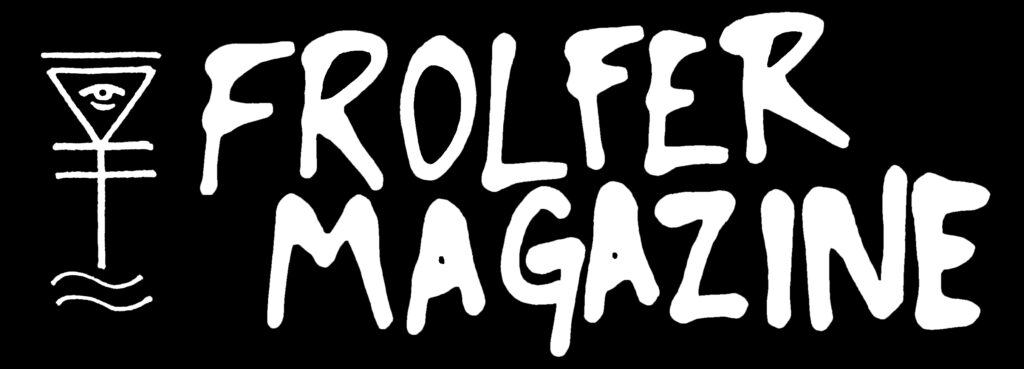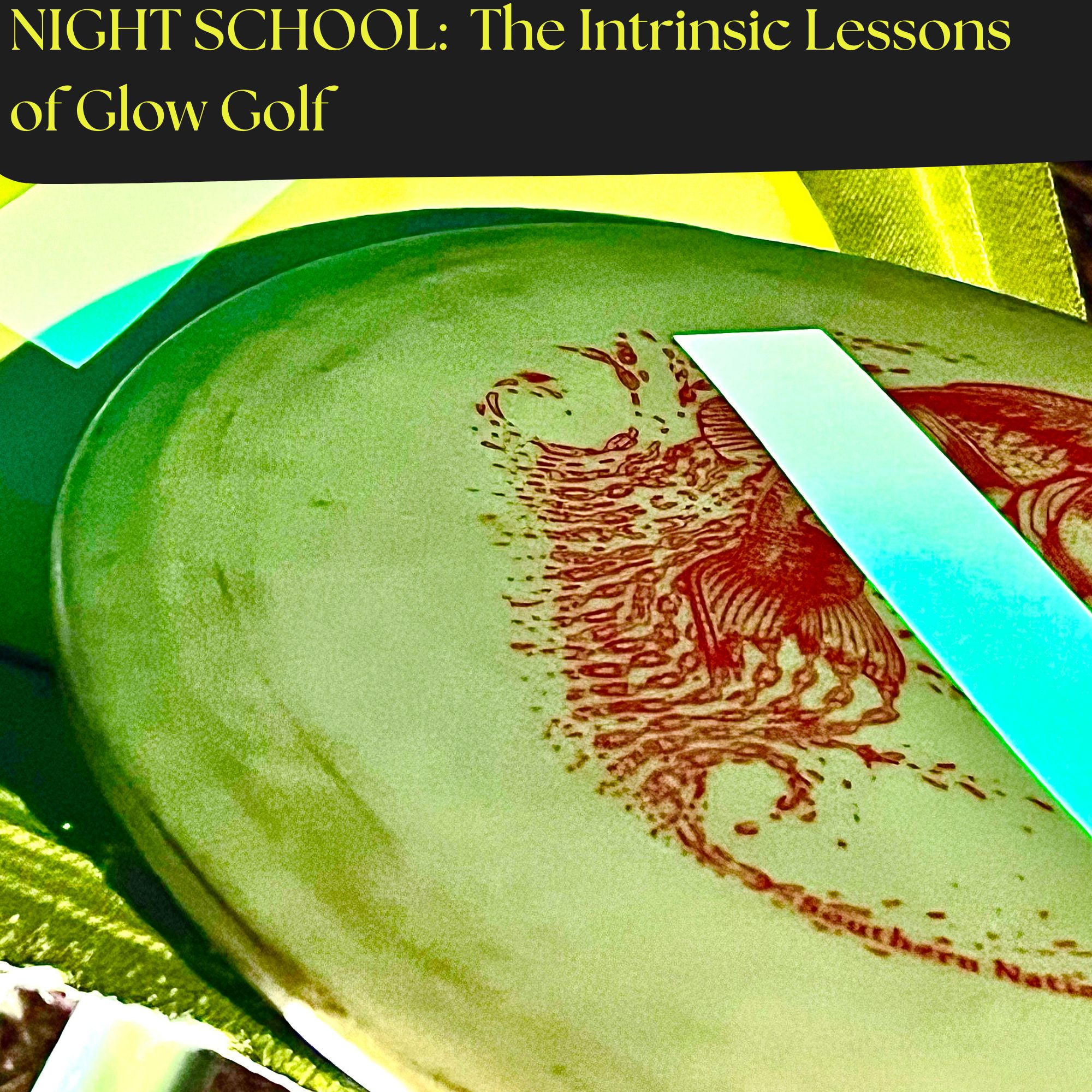Winter time certainly isn’t the best time for “serious” golf. Everything is suboptimal. The days are short, the weather is spotty. Our grip dries up due to the lack of humidity, and our discs fly differently than they do during the peak heat of the competitive season. What few pleasant days we have are spent on the course, cramming, trying desperately not to lose the hard-gotten gains of our summer skillset.
During these cruel and dreary months, many of us will flock to putting league: A fun-forward facsimile of putting practice that, at times, can add value to our game…if we let it.
But tossing back beers and lazy putts with your pals isn’t the whole package. We are fiends. We’re looking for our fix, and putting league is little more than secondhand smoke for the golfer’s soul. Like true addicts, we are willing to put ourselves in some uncomfortable situations in order to be sated.
Enter glow golf: As good a reason as you’ll find to slink around a public park under the cold cover of darkness.
Yes, this is disc golf in totality- The full course is under your feet once again, and your entire game will be tested. But there is one major caveat: You can’t see shit.
If you’ve somehow avoided glow golf, (but found yourself all the way down the niche rabbit hole to our little ol’ website), there isn’t all that much to explain.
You’ll either need some discs designed to glow in the dark, (or some glow-in-the-dark tape to adhere to your regular lineup), a flashlight for charging the glow, (UV and UV hybrids work best), and some way to light up your baskets. Then it’s just a matter of avoiding rolled ankles and hearty tree kicks that threaten to run out the clock on your disc’s ability to glow as you traipse gingerly around in the rough, searching.
This doesn’t sounds terribly interesting when you spell it out this way; it’s just regular disc golf at night with an additional tinge of precariousness and the air of mischief that acting nocturnal affords us. What is interesting is how the lack of light and sight affects our game, and teaches us lessons that one of the world’s most thoughtful golf pontificators has been preaching for decades.
When it comes to the game of Golf, with a capital G, the Venn diagram between the “ball” and “disc” versions has a heap of overlap. This is particularly true as it pertains to the space between the ears, and in the realm of strategy – both on and off the course. Knowing when and where to take the riskier line. Understanding what preparation your body needs for a particular course, tournament, or tour. These are universal in all of the Golfs out there, and no one has been better at dissecting the mental game than Dr. Bob Rotella, sports psychologist and author of the undeniable bible of Golf’s cerebral side, 1995’s Golf is Not a Game of Perfect.
In this seminal examination of the game within the game, Rotella explores and expounds the necessary separation of trust and technique in incredible detail, and suggests – very eloquently, I might add – that the golfer should be dealing in only one of these T’s at a time.
No paraphrasing of this concept is going to capture what Dr. Bob has discovered and so generously passed onto us, but the crude gist is this: If you are on the driving range, feel free to work on technique to your heart’s desire. This is the correct time and place to tinker on mechanics, routine, velocity, breath work, etc. But when you leave the range, all of the technique tweaking needs to stop. It needs to be locked away and hidden from view. Consider Technique tweaking a snake in the henhouse. It’s a stain on the brain while you’re on the course.
That’s because, according to the almighty Rotella, it is better for the golfer’s mind to rely on Trust and Trust alone while on the course. You trust yourself to put in the work, right? You trust yourself to eat the right meals and drink the right amount of drinks on the night before that regional A-Tier, don’t you? You trust that you did the field work? You trust what you saw with your own eyes on the range. You trust your technique, so lighten the mental load by carrying only Trust onto the first tee pad. Leave Technique at home. Technique has the day off. It’s Trust’s time to shine.
And guess, what – You need a whole lot of trust when you’re throwing frisbees in the woods in the thick of the night. You need to trust that you know where that one annoying guardian tree is. You need to trust that you know where your aim points are, even on a moonless night deep in rural America. Glow golf’s blind uncertainty is reinforcing, by force, Rotella’s concept of separating Trust from Technique, and doing so in such a way that all golfers are absorbing the knowledge even if they’re oblivious to the lesson.
Another innate lesson that glow golf can provide us is that of simplicity, or how to unburden ourselves on the course.
Not all manufacturers make all of their discs in glow material, and there certainly isn’t a glow equivalent in every plastic blend. As such, options are limited when it comes to building a night-bright bag. Glow tape exists and works extremely well, but can be undesirable for a few reasons: The size of the glowing surface is smaller when it comes time to find an errant shot, and the weight of the tape makes it technically illegal for PDGA sanctioned play in non-glow settings.
Naturally, many golfers find themselves having to make rather sizable adjustments to their quivers for night flights, relying on perhaps one individual disc of a particular mold instead of the carefully curated collection of seasoned throwers in their usual arsenal. While this may seem to be a mildly irritating reality of glow golf, this forced simplicity can be transformative to our game in the long run. Instead of relying on that 6-season-old Buzz that flips to the right and holds on for dear life, you find yourself experimenting on angle control with some stiff, still-stable, glow version of a Buzz. It may be a little uncomfortable, but you’re learning something, and you’re again flexing the Trust muscle – trusting that you know how to adapt and adjust, and trusting that you have enough of a grasp on flight physics to be successful.
Simplifying your bag also narrows your shot selection to some extent, forcing you to improvise on courses that you might play weekly. You may have to consider a different landing zone, or another lane altogether. It’s a bit like playing a course blind, (literally and figuratively), in that it forces us to slow down, think a little more, and play generally safer shots. While maybe a little less exciting, these sorts of rounds are important for the overall development of our personal game. (All score-y, no glory). They are rounds in which we are unburdened by the unattainable carrot called perfection at the end of the stick called golf. By eschewing the main storyline for a fun little night-time side quest, we remind ourselves that it’s okay to just have fun sometimes. This also helps to shut off the clinical, technique brain, thus reinforcing ol’ Bobby R’s wise words.
Golf is a game unconquerable, upon which we affix a near-literal blindfold by playing at night. Perhaps the most important, unavoidable lesson of glow golf is how to shed our perfectionist tendencies in pursuit of trust, knowing that we can only do what we can do against the course, against the elements, and against, now, the dark. This mindset is a quieter one; one that is more prone to thinking clearly and concisely on the course, free of extraneous noise, the same way that a dark fairway appears to be free of branches and trunks. In this way, our obstacles, both mental and physical, can disappear in the night.
The trouble between the ears and the trouble between the limbs are both closer to invisible during night golf, and thus infuse us with a useful boost of confidence to take back out under the sweltering summer sun when the time comes.

